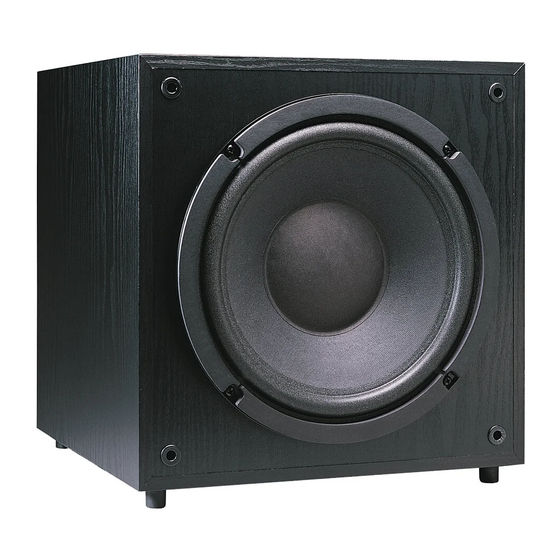
Advertisement
Table of Contents
- 1 Table of Contents
- 2 Unpacking and Installation
- 3 Mains Connection
- 4 Standard Amplifier - Speaker Cable Connection
- 5 Satellite Speaker Wiring Option 1
- 6 Speaker Level High Pass Filter
- 7 Main/Satellite Speaker Wiring Option 2
- 8 Plugging in the Subwoofer
- 9 Fine Tuning
- 10 Trouble Shooting
- 11 Specifications
- Download this manual
Advertisement
Table of Contents

Summarization of Contents
Guarantee and Service Information
Claims Under Guarantee Procedure
Procedure for returning equipment for warranty claims and contact details.
Unpacking and Installation Guide
Initial Gain Control Setting
Setting the gain level for initial trials based on system configuration.
Initial Frequency Control Setting
Setting the crossover frequency for initial trials based on speaker size.
Initial Phase Control Setting
Setting the phase control to 0 degrees for initial trials.
Initial Mode Switch Setting
Setting the mode switch to audio or video for initial trials.
Safety Instructions
General Safety Guidelines
General advice on reading, retaining, and following all operating instructions.
Water and Moisture Precautions
Avoid using the appliance near water or placing items on it.
Positioning Safety
Appliance designed for floor mounting only, ensure proper placement.
Ventilation Requirements
Ensure proper airflow and avoid obstructing ventilation openings.
Heat Source Avoidance
Do not place near radiators, fires, or direct sunlight.
Power Source Guidelines
Connect only to the specified power supply type as marked.
Power Cord Protection
Route cords safely to prevent damage or pinching.
Non-Use Period Precautions
Unplug the appliance when left unused for long periods.
Cleaning Instructions
Unplug power lead before cleaning with a soft dry cloth.
Liquid Entry Warning
Avoid spilling liquids, especially near the power cord entry.
Service Requirements
List of conditions requiring qualified service personnel.
User Servicing Limitations
Users should not attempt servicing beyond operating instructions.
Mains Connection and Placement
Position and Location Guidelines
Proper placement for ventilation and to avoid magnetic interference with TVs.
Placement Restrictions
Avoid placing directly against walls, near heaters, or in humid environments.
Subwoofer Controls and Connections
Power Switch with Auto Off
Explains the power switch functionality for different models (Auto On/Off).
Mode Switch
Sets desired gain level for audio or home cinema modes for optimal response.
Level/Gain Control
Adjusts subwoofer level for a totally controlled balanced sound.
Crossover/Frequency Control
Controls the frequency at which the subwoofer rolls off.
Phase Control
Synchronizes the phase of the subwoofer with main/satellite speakers.
RCA Phono Output (FB210 only)
Facility for linking to additional amplifiers or daisy-chaining subwoofers.
RCA Phono Input Connection
Recommended line-level connection from pre-amplifier or A.V. receiver.
High Level Input
Connects directly from amplifier output terminals using speaker cables.
High Level Output
Provides output to main speakers when using high-level input.
Mains Fuse
Information on replacing the mains fuse with the exact specification.
Mains Connection
Standard 3-pin IEC style socket for power connection.
Voltage Selector
Switch for selecting mains voltage (115V/230V); factory set.
Speaker Cable Connection Methods
Standard Amplifier Speaker Cable Connection
Connecting the subwoofer to the amplifier using loudspeaker cables.
Satellite Speaker Wiring Option 1
Connecting main/satellite speakers directly to the subwoofer's high-level output.
Main/Satellite Speaker Wiring Option 2
Connecting main/satellite speakers directly to the amplifier.
Wiring with Pre-Amplifier
Pre-Amplifier RCA Input Connection
Connecting the subwoofer to line-level components via RCA inputs.
Plugging In and Fine-Tuning
Plugging in the Subwoofer
Steps for plugging in the subwoofer and its standby mode behavior.
Fine-Tuning Procedure
Adjusting phase, gain, and frequency for optimal sound balance.
Troubleshooting Common Issues
No Sound from Subwoofer
Checks for power, input connections, and phasing issues.
Excessive Bass
Troubleshooting steps for too much bass, including positioning.
Inadequate Bass
Troubleshooting steps for insufficient bass, re-checking setup.
Vibrating Noise
Checking for external items causing vibration with deep bass sounds.
















Need help?
Do you have a question about the FB210 and is the answer not in the manual?
Questions and answers